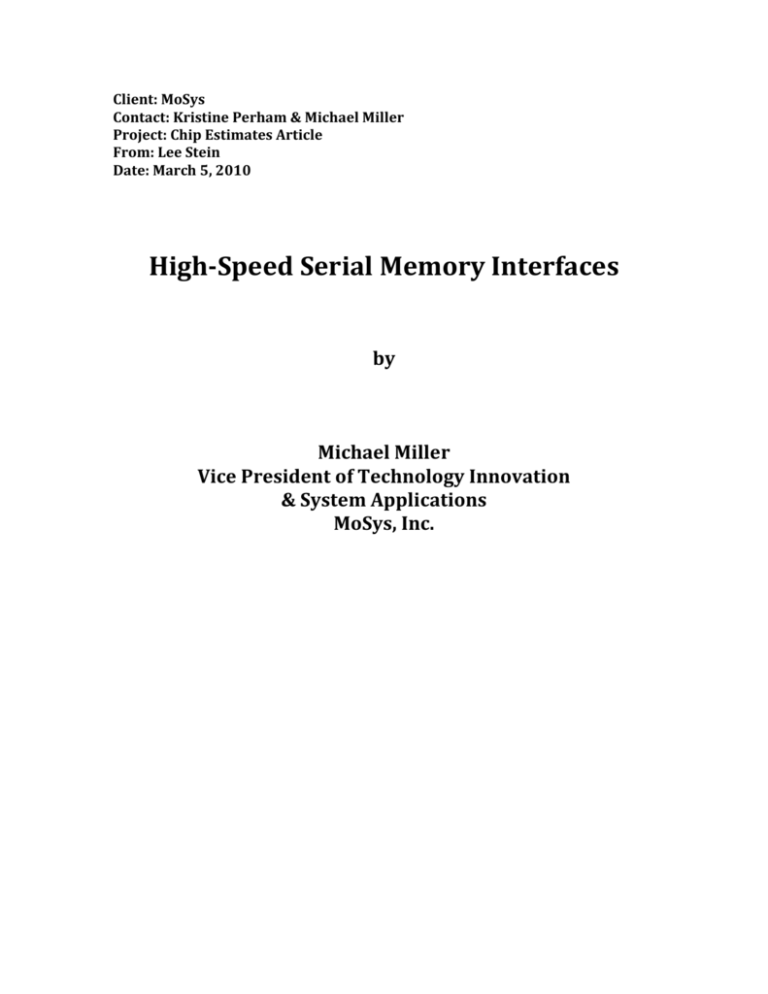
Client: MoSys
Contact: Kristine Perham & Michael Miller
Project: Chip Estimates Article
From: Lee Stein
Date: March 5, 2010
High-Speed Serial Memory Interfaces
by
Michael Miller
Vice President of Technology Innovation
& System Applications
MoSys, Inc.
Introduction:
Serial communications have come a long way from their original implementations in
Morse Code transmissions via telegraph, undersea cables, and microwave. New
generations of engineers have recognized the efficacy of serial solutions and
implemented them at increasingly lower system levels. This progression has
manifested in backplane communications standards such as PCI Express, XAUI, FDDI
(for disk drives), InterLaken and more. Present day FPGAs, ASICs and NPUs sport
SerDes (Serializer/Deserializer) 11+ Gbps interfaces. The benefits of these
implementations result in cost-effective, lower pin count designs.
Designers today face the roadblocks of parallel configurations in device-to-device
communications. Namely, they’re running out of I/O as networking memory device
suppliers increase bandwidth by 2 – 4x to meet next-level networking equipment
requirements. A new open standard protocol overcomes pin count, cost, efficiency,
and energy consumption hurdles for small sized packets typically found in 10G, 40G
and 100G networking memory applications.
Why Device-to-Device = Serial
Figure 1
Picture Sources: http://www.theinquirer.net/inquirer/news/1037859/there-magic-intel-fb-dimm-buffer;
http://www.simmtester.com/page/news/showpubnews.asp?num=113;
http://www.icc-usa.com/Fully-Buffered-DIMM-0305.pdf
Above left in Figure 1, the board is laid out using parallel interconnects. On the right,
by comparison, the same design was executed using serial interconnects. One
immediately observes the reduced real estate required by the serial layout on the
right. The cause: Using serial communication increases bandwidth density, resulting
in a reduced number of traces, since serial only requires a matched differential pair.
Serial protocols like XAUI, InterLaken and PCIe include deskewing mechanisms to
handle any mismatch between data lines.
SerDes electrical standards groups support this development with the Optical
Interface Forum (OIF), which provides for common electrical interface for 3, 6, 11
and 28 Gigabit onboard and backplane interconnects. Other relevant standards
include IEEE 1, 10, 40, and 100 Gigabit Ethernet and FDDI (for disk drives), SATA,
and USB.
Serial vs Parallel – And the Winner Is…
Serial latency is measured from the first bit in to the first bit out. System designers
can approximate serial latency by applying the following formula: Serial latency = #
of clocks to deserialize + deskew + memory latency + # of clocks on the first bit out.
Comparing a 1GHz DDR parallel to 10 Gbps serial transmission rate moving 80 bits
of information, the parallel bus uses 40 data lines, a 2:1mux register, and clocks one
half of the 80 bits on the rising and falling edges of the I/O clockin 1 ns. In contrast,
serial transmission uses 8 pairs, serialization/deserialization registers operating at
10 GHz and completes the same task in 1ns as well. The data rate for serial
transmission thus approaches the vanishing point of break-even compared with
parallel buses. The only real difference is in the deserialization time. In short, a
serial bus running at 10 Gbps runs as fast as a parallel bus.
In some applications, latency is not as important. For example, networking
equipment transmits packets through a line card and across the backplane. In this
case, high throughput is more valuable than overall latency. On the other hand,
when the system needs to repeatedly access a memory block to process a packet,
the latency of the memory is multiplied several fold. This determines how many
packets must be stored and processed in parallel thus increasing the complexity of
the storage architecture. In other cases, some tasks MUST be completed before the
next packet in the same flow arrives. The latency of the memory and the interface
again come into play. So latency can in fact be important.
New Serial Protocol Applied: 72b Transmission
As data rates increase and electrical signals shrink, the probability of an incorrectly
sampled data bit increases, regardless of whether the interface is serial or parallel.
At one GHz and beyond for telecommunications interfaces, even parallel interfaces
need to consider some sort of error checking and handling solution. Because of their
higher data rates and farther reach, serial interfaces have always required a higherlevel protocol. As such, serial designs have always included mechanisms to insure
data integrity. For example, today’s assumed error rate is 10-15. In PC board
applications, SerDes devices may achieve a much better rate (10-18), but it’s hard to
measure.
Many serial protocols are available to designers today including PCIe, SRIO (Serial
Rapid IO), Interlaken Look-aside, and SFI-S. These protocols reliably transport
variable length packets of information between multiple endpoints across congested
switches with priority control. Point-to-point protocols like Interlaken handle
multiple flows with variable length packets and per flow rate control, which
requires multiple fields. Each of these fields adds to the minimum packet overhead,
which lowers efficiency when transmitting small packets. When transporting 100
byte messages, the overhead for the data protocol consists of only 10% of the entire
message, meaning the transmission efficiency is 90%.
For 72-bit data word transmissions needed in networking memory, the protocol
overhead dominates and results in transmission efficiency of approximately 37%.
For a 72-bit transmission, the protocol overhead for SRIO totals 64 bits, for PCIe
totals 96b/128b, and the CRC totals 16b. Total overhead for SRIO totals 80 bits and
for PCIe, up to 144b.
The question for designers: How to reliably transport data without the overhead,
since these protocols address issues not relevant in point-to-point control? When
transmitting a large packet of information, such as 64 bytes or more, a few bytes of
overhead don’t matter. However, when transmitting a small packet of information
using the same protocol, the number of bytes devoted to protocols does make a
significant difference.
Figure 2
Figure 2 above demonstrates that if the transmission can eliminate most of the
protocol overhead, the result is high efficiency. For Packet Data Units (PDUs)
between four bytes and eight bytes such as transmission of single data words
between and SOC device and memory, the transmission is very inefficient.
Figure 3
Using the GigaChip™ Interface (developed by MoSys®, Inc.) to transmit data in the
range of four to eight bytes addresses only one thing: since bit errors occur
infrequently (10-15), the transmission packets can eliminate most of the protocol
overhead. As shown in Figure 3 above, this results in approximately a 90%
efficiency to transmit 72 bits of data plus 8 bits for CRC and Ack. With CRC the
probability of an undetected bit error drops to <10-23.
When the protocol becomes independent of the number of lanes or connections –
serial designs become scalable. If designers select protocols carefully, and make
them independent of the physical number of lanes, the industry can implement
solutions in 1, 2, 4, 8, 16 lanes or more. The designer can either scale the number of
lanes and/or scale the data rate on each one of those serial lanes. The reason
scalability matters is that bandwidth has its own cost in terms of board materials,
packaging materials, board real estate, etc.
Using high overhead protocols for 4-8 Byte PDUs results in inefficiency, which
means that the design sacrifices bandwidth. Eliminating the protocol overhead of
each transmission solves the inefficiency problem and results in very high-speed
transmission of raw data. For example, at a data rate per channel of 16 Gbps using
16 channels, a serial connection will transmit 3.2 Giga operations per second (Gops)
and 230.4 Gbps.
Signal Integrity
Nothing comes for free. As signals enter the GHz rage, designers must be aware of
the signal integrity aspects of high-speed channels. This will be true whether the bus
is parallel or serial. The trade-off being that parallel buses run slower, but have
many more channels to model and control. Serial will be proportionally running at a
much higher rate, but the number of channels is proportionally less. Because of the
push on serial channels for moving packets across backplanes, tools have been
developed to solve this problem. Keeping in mind that on the board, the channels
will be much shorter and less complicated, thus making the task to design a high
speed chip-to-chip link much more manageable.
Conclusion
In its simplest statement, the design choice between serial and parallel used to boil
down to number of interconnects vs. speed. Because parallel requires a high number
of interconnects, it increases device real estate, always a downside. Given the
continued progression in transmission solutions, parallel buses are reaching the end
of their natural life. Based on Moore’s Law as applied to packaging, to achieve
double the bandwidth using parallel, the device must double the pins, which is no
longer very likely. And for the same reason, parallel buses are not likely to double.
In response to the demise of parallel interconnects, MoSys has developed and
introduced the new open standard GigaChip interface protocol. As a result, small
device-to-device transmissions achieve 90% efficiency.
MoSys is a registered trademark of MoSys, Inc. The MoSys logo and GigaChip are trademarks of MoSys, Inc.
Copyright © 2010 MoSys, Inc. All rights reserved.








